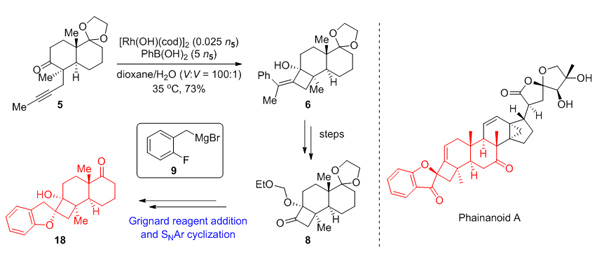149.Synthetic Study Toward the 4,5-Spirocycle Skeleton of Phainanoids
Jiang, Chongguo†, Chen, Sijia†, Gong, Jianxian*, Yang, Zhen*
Acta Chim. Sinica 2020, 78(9), 928—932
Attempts to synthesize the 4,5-spirocycle skeleton of Phainanoids by rhodium-catalyzed arylative cyclization of alkynone 5 and the addition of Grignard reagent 9 to α-alkoxyl cyclobutone 8, followed by intramolecular SNAr reaction are reported. Phainanoids, highly modified triterpenoids, were isolated from Phyllanthus hainanensis by Yue and co-workers. They have been found to show intriguing immunosuppressive activities. The most potent of them, Phainanoid F, inhibit the proliferation of T cells with an IC50 value of (2.04±0.01) nmol/L and B cells with an IC50 value <(1.60±0.01) nmol/L. The noteworthy activities and the lack of Phainanoids in nature resources make the synthesis of them for further biological evaluation a challenge for chemists. Our synthesis started from known compound 1, after Birch reduction and alkylation to give alkynone 5. The rhodium-catalyzed arylative cyclization of alkynone 5 to deliver tetrasubstituted cyclobutene 6 was performed by the following procedure. Under an atmosphere of Ar, to an oven-dried Schlenk tube with[Rh(OH)(cod)]2 (35.5 mg, 0.078 mmol, 0.012n5), phenylboronic acid (2.0 g, 16.3 mmol, 2.5n5), were added a solution of ketone 5 (1.9 g, 6.5 mmol, 1.0n5) in 1,4-dioxane (32.0 mL) and H2O (0.3 mL) at room temperature. The mixture was stirred at 35℃ for 12 h. Another [Rh(OH)(cod)]2 (35.5 mg, 0.078 mmol, 0.012n5) and phenylboronic acid (2.0 g, 16.3 mmol, 2.5n5) was added to the mixture. The mixture was stirred at 35℃ for 12 h. Subsequently, hydroxyl group was protected with ethoxymethyl (EOM) group to furnish 7, followed by ozonolysis to generate ketone 8. Ketone 8 was reacted with fresh prepared Grignard reagent 9 in Felkin-Anh modelinstead ofthe Cram’s chelation-control model to deliver alcohol 10. The explanation of the diastereoselectivity of this reaction could be illustrated from two aspects:(1) the rigid structure of α-alkoxyl cyclobutone 8 increased the energy barrier for the transition state of chelation between magnesium ions and alkoxyl substituent; (2) the magnesium ions were not chelated with the alkoxyl substituent as well as the carbonyl oxygen was due to the intramolecular chelation with fluorine atom. Alcohol 10 underwent intramolecular SNAr reaction and deprotection to deliver 4,5-spirocycle compound 18.

